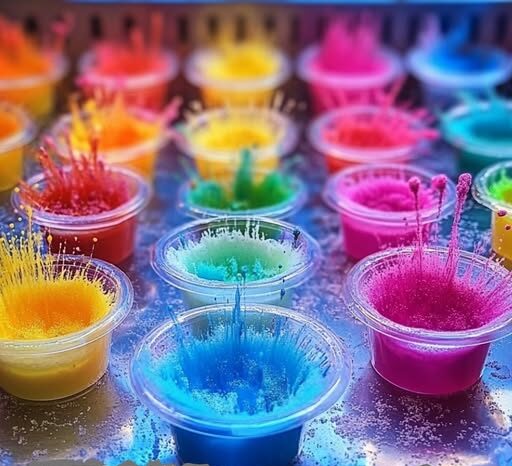Baking Soda and Vinegar Fireworks is a fun, safe, and kid-friendly science experiment that mimics mini fireworks with fizzing and popping action all without actual fire or explosions.
🎆 Baking Soda and Vinegar “Fireworks”
What You’ll Need:
-
Baking soda (sodium bicarbonate)
-
Vinegar (white vinegar works best)
-
Food coloring (optional, for a colorful effect)
-
Small plastic cups or containers (clear ones let you see the reaction)
-
A baking tray or large shallow pan (to contain mess)
-
Plastic pipette, spoon, or small measuring cup
Optional Add-ons:
-
Glitter (for sparkle — use eco-friendly glitter if possible)
-
Dish soap (adds foaminess and height to the reaction)
Instructions:
🔬 Step 1: Prepare the Base
-
Add baking soda to the bottom of each small container or section of a muffin tin — about 1–2 tablespoons per compartment.
-
Optional: Mix in a few drops of food coloring and glitter with the baking soda for a fun effect.
-
Optional: Add a tiny squirt of dish soap to enhance the foamy “explosion.”
🧪 Step 2: Add the Vinegar
-
Use a pipette, spoon, or small cup to slowly pour vinegar over the baking soda.
-
Watch as the colorful fizzy “fireworks” erupt — the acid-base reaction creates CO₂ gas, making it bubble and foam.
💡 Science Behind It:
-
Baking soda (a base) reacts with vinegar (an acid) to form carbon dioxide gas (CO₂).
-
The gas bubbles create the fizzing, popping, and foam — mimicking the burst of fireworks (just without the boom and heat).
✅ Safety Tips:
-
Always do this experiment on a surface you can clean easily (or use a tray).
-
Use non-toxic ingredients if kids are involved.
-
Do it outdoors or on a protected surface if you’re using a lot of vinegar.
🎨 Fun Variations:
-
Make a “fireworks painting” by doing the experiment on paper placed in a tray.
-
Use ice cube trays to create multiple fizzing colors at once.
-
Try using lemon juice instead of vinegar for a natural variation.
